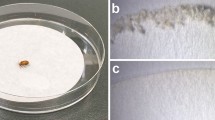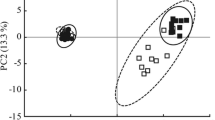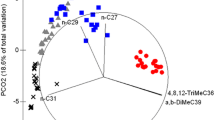Abstract
Ithomiine butterflies (Nymphalidae) have long-lived, aposematic, chemically protected adults. However, little is known about the defense mechanisms in larvae and other juvenile stages. We showed that larvae Mechanitis polymnia are defended from ants by a chemical similarity between their cuticular lipids and those of the host plant, Solanum tabacifolium (Solanaceae). This is a novel defense mechanism in phytophagous insects. A field survey during one season showed that larval survivorship was up to 80%, which is high when compared with other juvenile stages. In a laboratory bioassay, live larvae on their host plant were not attacked by the predatory ant Camponotus crassus (Formicidae). Two experiments showed that the similarity between the cuticular lipids of M. polymnia and S. tabacifolium protected the larvae from C. crassus: (a) when the caterpillar was switched from a host plant to a non-host plant, the predation rate increased, and (b) when a palatable larva (Spodoptera frugiperda, Noctuidae) was coated with the cuticular lipids of M. polymnia and placed on S. tabacifolium leaves, it no longer experienced a high predation rate. This defensive mechanism can be defined as chemical camouflage, and may have a double adaptive advantage, namely, protection against predation and a reduction in the cost of sequestering toxic compounds from the host plant.


Similar content being viewed by others
References
M. D. Bowers (1993) Aposematic caterpillars: life-styles of the warningly colored and unpalatable N. Stamp T. M. Casey (Eds) Caterpillars. Ecological and Evolutionary Constraints on Foraging Chapman & Hall New York, NY 331–371
K. S. Brown SuffixJr. (1984) ArticleTitleAdult obtained pyrrolizidine alkaloids defend Ithomiinae butterflies against a spider predator Nature 309 707–709 Occurrence Handle10.1038/309707a0
K. S. Brown SuffixJr. (1985) ArticleTitleChemical ecology of dehydropyrrolizidine alkaloids in adult Ithomiinae (Lepidoptera: Nymphalidae) Rev. Bras. Biol. 44 435–460
K. S. Brown SuffixJr. (1987) ArticleTitleChemistry at the Solanaceae/Ithomiinae interface Ann. Mo. Bot. Gard. 74 359–397
K. S. Brown SuffixJr. A. V. L. Freitas (1994) ArticleTitleJuvenile stages of Ithomiinae: overview and systematics (Lepidoptera: Nymphalidae) Trop. Lep. 5 9–20
J. S. Buckner (1993) Cuticular polar lipids of insects D. W. Stanley-Samuelson D. R. Nelson (Eds) Insect Lipids: Chemistry, Biochemistry and Biology University of Nebraska Press Lincoln, NE 227–270
V. H. Cornell B. A. Hawkins (1995) ArticleTitleSurvival patterns and mortality sources of herbivorous insects: some demographic trends Am. Nat. 145 563–593 Occurrence Handle10.1086/285756
K. Dettner C. Liepert (1994) ArticleTitleChemical mimicry and camouflage Annu. Rev. Entomol. 39 129–154 Occurrence Handle10.1146/annurev.en.39.010194.001021
B. A. Drummond SuffixIII K. S. Brown SuffixJr. (1987) ArticleTitleIthomiinae (Lepidoptera: Nymphalidae): Summary of known larval foodplants Ann. Mo. Bot. Gard. 74 341–358
J. A. Endler (1981) ArticleTitleAn overview of the relationships between mimicry and crypsis Biol. J. Linn. Soc. 16 23–31
K. E. Espelie E. A. Bernays J. J. Brown (1991) ArticleTitlePlant and insect cuticular lipids serve as behavioral cues for insects Arch. Insect Biochem. Physiol. 17 223–233 Occurrence Handle10.1002/arch.940170406
D. L. Evans J. O. Schmidt (1990) Insect Defenses. Adaptative Mechanisms and Strategies of Prey and Predators State University of New York Press Albany, NY
D. A. Fishlyn D. W. Phillips (1980) ArticleTitleChemical camouflaging and behavioral defenses against a predatory seastar by 3 species of gastropods from the surf-grass Phyllospadix community Biol. Bull. 158 34–48
A. V. L. Freitas P. S. Oliveira (1996) ArticleTitleAnts as selective agents on herbivore biology: effects on the behaviour of a non-myrmecophilous butterfly J. Anim. Ecol. 65 205–210
A. V. L. Freitas J. R. Trigo K. S. Brown SuffixJr. L. Witte T. Hartmann L. E. S. Barata (1996) ArticleTitleTropane and pyrrolizidine alkaloids in the ithomiines Placidula euryanassa and Miraleria cymothoe (Lepidoptera: Nymphalidae) Chemoecology 7 61–67 Occurrence Handle10.1007/BF01239482
M. I. Haverty B. L. Thorne L. J. Nelson (1996) ArticleTitleHydrocarbons of Nasutitermes acajutlae and comparison of methodologies for sampling cuticular hydrocarbons of Caribbean termites for taxonomic and ecological studies J. Chem. Ecol. 22 2081–2110 Occurrence Handle10.1007/BF02040096
M. E. Hay E. Duffy W. Fenical (1990) ArticleTitleHost-plant specialization decreases predation on a marine amphipod: an herbivore in plant's clothing Ecology 71 733–743
B. Hölldobler E. O. Wilson (1990) The Ants The Belknap Press of Harward University Cambridge, MA
R. W. Howard (1993) Cuticular hydrocarbons and chemical communication D. W. Stanley-Samuelson D. R. Nelson (Eds) Insect Lipids: Chemistry, Biochemistry and Biology University of Nebraska Press Lincoln, NE 179–226
R. W. Howard G. J. Blomquist (2005) ArticleTitleEcological, behavioral, and biochemical aspects of insects hydrocarbons Annu. Rev. Entomol. 50 371–393 Occurrence Handle10.1146/annurev.ento.50.071803.130359 Occurrence Handle15355247
R. W. Howard C. A. McDaniel G. J. Blomquist (1980) ArticleTitleChemical mimicry as an integrating mechanism: cuticular hydrocarbons of a termitophile and its host Science 210 431–433
N. Kusnezov (1951) ArticleTitleEl género Camponotus en la Argentina Acta Zool. Lilloana XII 183–255
A. Lenoir P. D'Ettorre C. Errard (2001) ArticleTitleChemical ecology and social parasitism in ants Annu. Rev. Entomol. 46 573–599 Occurrence Handle10.1146/annurev.ento.46.1.573 Occurrence Handle11112180
A. R. Masters (1990) ArticleTitlePyrrolizidine alkaloids in artificial nectar protect adult ithomiine butterflies from a spider predator Biotropica 22 298–304
Masters, A. R. 1992. Chemical defense in Ithomiinae butterflies (Nymphalidae: Ithomiinae). PhD dissertation, University of Florida, Gainesville, FL.
R. J. Nash M. Rothschild E. A. Porter A. A. Watson R. D. Waigh P. G. Waterman (1993) ArticleTitleCalystegines in Solanum and Datura species and the deaths-head hawk-moth Phytochemistry 34 1281–1283 Occurrence Handle10.1016/0031-9422(91)80016-T
J. Orivel A. Dejean (2000) ArticleTitleMyrmecophily in Hesperiidae. The case of Vettius tertianus in ant gardens Life Sci. 323 705–715
A. G. Orr J. R. Trigo L. Witte T. Hartmann (1996) ArticleTitleSequestration of pyrrolizidine alkaloids by larvae of Tellervo zoilus (Lepidoptera: Ithomiinae) and their role in the chemical protection of adults against the spider Nephila maculata (Araneidae) Chemoecology 7 68–73 Occurrence Handle10.1007/BF01239483
Portugal, A. H. A. 2001. Defesa química em larvas da borboleta Mechanitis polymnia (Nymphalidae: Ithomiinae). MSc dissertation. Universidade Estadual de Campinas. Campinas, São Paulo, Brazil
B. A. Salazar D. W. Whitman (2001) Defensive tactics of caterpillars against predators and parasitoids T. N. Ananthakrishnan (Eds) Insect and Plant Defense Dynamics Science Publishers Inc. Portland, OR 161–207
T. Singer (1998) ArticleTitleRoles of hydrocarbons in the recognition systems of insects Am. Zool. 38 394–405
J. T. Smiley (1985) ArticleTitleHeliconius caterpillars mortality during establishment on plants with and without attending ants Ecology 67 516–521
J. J. Stachowicz M. E. Hay (1999) ArticleTitleReducing predation through chemically mediated camouflage: indirect effects of plant defenses on herbivores Ecology 80 495–509
M. K. Stowe (1988) Chemical mimicry K. C. Spencer (Eds) Chemical Mediation of Coevolution Academic Press New York, NY 513–580
J. R. Trigo K. S. Brown SuffixJr. (1990) ArticleTitleVariation of pyrrolizidine alkaloids in Ithomiinae: a comparative study between species feeding on Apocynaceae and Solanaceae Chemoecology 1 22–29 Occurrence Handle10.1007/BF01240582
J. R. Trigo K. S. Brown SuffixJr. L. Witte T. Hartmann L. Ernst L. E. S. Barata (1996) ArticleTitlePyrrolizidine alkaloids: different acquisition and use patterns in Apocynaceae and Solanaceae feeding ithomiine butterflies (Lepidoptera: Nymphalidae) Biol. J. Linn. Soc. 58 99–123 Occurrence Handle10.1006/bijl.1996.0028
R. K. Meer ParticleVander L. Morel (1998) Nestmate recognition in ants R. K. Meer ParticleVander M. D. Breed M. L. Winston K. E. Espelie (Eds) Pheromone Communication in Social Insects. Ants, Wasps, Bees, and Termites Westview Press Boulder, CO 79–103
R. K. Meer ParticleVander D. P. Wojcik (1982) ArticleTitleChemical mimicry in the myrmecophilous beetle Myrmecaphodius excavaticollis Science 218 806–808
R. I. Vane-Wright (1976) ArticleTitleAn unified classification of mimetic resemblances Biol. J. Linn. Soc. 8 25–56
H. P. Young C. Schal (1997) ArticleTitleCuticular hydrocarbon synthesis in relation to feeding and developmental stage in nymphs of Blattella germanica (Dictyoptera: Blattellidae) Ann. Entomol. Soc. Am. 90 655–663
Acknowledgments
This work is part of a Master of Science dissertation by AHAP and was supported by grants from FAPESP (98/01065-7 to JRT and 98/00765-5 to AHAP). The authors thank D. Whitmann, E. Bernays, P.S. Oliveira, A.V.L. Freitas, F. Nogueira-de-Sá, M. Hilker, and four anonymous reviewers for valuable comments on the manuscript. We thank also the Instituto Agronômico de Campinas, Fundação José Pedro de Oliveira de Campinas, Prefeitura Municipal de Jundiaí, and Instituto Botânico de São Paulo for permission to work in their areas.
Author information
Authors and Affiliations
Corresponding author
Rights and permissions
About this article
Cite this article
Henrique, A., Portugal, A. & Trigo, J.R. Similarity of Cuticular Lipids Between a Caterpillar and Its Host Plant: A Way to Make Prey Undetectable for Predatory Ants?. J Chem Ecol 31, 2551–2561 (2005). https://doi.org/10.1007/s10886-005-7613-y
Received:
Revised:
Accepted:
Published:
Issue Date:
DOI: https://doi.org/10.1007/s10886-005-7613-y




